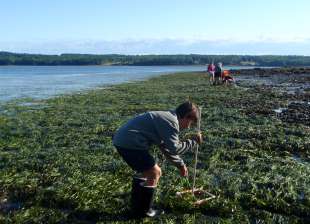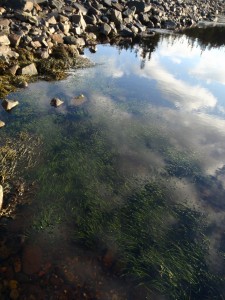 Mount Desert Island Biological Laboratory (MDIBL) is working to restore eelgrass habitat that serves as essential nursery areas for commercially important marine species in the Gulf of Maine. Eelgrass (Zostera marina) is a unique flowering plant, formerly occurring in widespread meadows in sub-tidal areas along many coastlines in the Northern Hemisphere. As one of the primary photosynthetic producers, and as nursery habitat for many species, it plays a crucial role in the ecology of the Gulf of Maine. In Frenchman Bay, eelgrass has recently experienced significant declines, possibly related to dragging for mussels and other sessile species.
Mount Desert Island Biological Laboratory (MDIBL) is working to restore eelgrass habitat that serves as essential nursery areas for commercially important marine species in the Gulf of Maine. Eelgrass (Zostera marina) is a unique flowering plant, formerly occurring in widespread meadows in sub-tidal areas along many coastlines in the Northern Hemisphere. As one of the primary photosynthetic producers, and as nursery habitat for many species, it plays a crucial role in the ecology of the Gulf of Maine. In Frenchman Bay, eelgrass has recently experienced significant declines, possibly related to dragging for mussels and other sessile species.
 At Hadley Point in upper Frenchman Bay, the bottom coverage was estimated at 60 – 80% cover in 1996, declining to <0.5% by 2007. Over the last four summers, MDIBL has worked in partnership with multiple community groups to restore eelgrass at Hadley Point. Efforts to date have had demonstrable success. The coverage in the restoration reserve has increased from a low of 0.5% in 2007 to approximately 15% in 2011. Moreover, while 74 square meters of eelgrass had been transplanted over the past 5 summers, a recent census revealed 3500 square meters of coverage, nearly a 48-fold increase. In addition, new eelgrass beds have developed in nearby areas of the bay. Current tracking data suggest that seed is travelling from the restoration area to new eelgrass sites around the bay. Juvenile mussels are the predominant marine organism inhabiting eelgrass blades in the restoration area during the summer months. Future plans include optimizing eelgrass restoration methods and expanding eelgrass restoration efforts around Frenchman Bay with funding from Constellation Energy.
At Hadley Point in upper Frenchman Bay, the bottom coverage was estimated at 60 – 80% cover in 1996, declining to <0.5% by 2007. Over the last four summers, MDIBL has worked in partnership with multiple community groups to restore eelgrass at Hadley Point. Efforts to date have had demonstrable success. The coverage in the restoration reserve has increased from a low of 0.5% in 2007 to approximately 15% in 2011. Moreover, while 74 square meters of eelgrass had been transplanted over the past 5 summers, a recent census revealed 3500 square meters of coverage, nearly a 48-fold increase. In addition, new eelgrass beds have developed in nearby areas of the bay. Current tracking data suggest that seed is travelling from the restoration area to new eelgrass sites around the bay. Juvenile mussels are the predominant marine organism inhabiting eelgrass blades in the restoration area during the summer months. Future plans include optimizing eelgrass restoration methods and expanding eelgrass restoration efforts around Frenchman Bay with funding from Constellation Energy.
